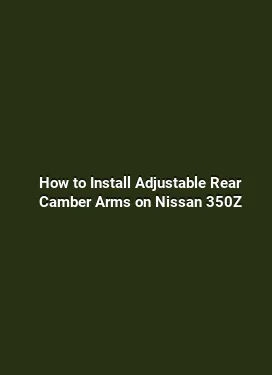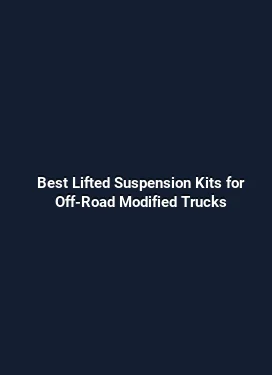How to Install Air Lift Performance 3H Air Suspension Kit
Optimum ride quality, adjustable stance, and predictable handling are the hallmarks of a well-installed air suspension system. The Air Lift Performance 3H Kit brings automated height adjustment, ride control, and load leveling into a compact, performance-focused package. This comprehensive guide walks through the installation, calibration, and fine-tuning process, with practical tips drawn from real-world use. Expect to engage in a project that blends mechanical aptitude with precise electrical connections, careful air line routing, and thoughtful weight distribution considerations. The result is a vehicle that maintains stable alignment under varying loads and road conditions, delivering consistent grip and smoother responses during cornering, braking, and highway cruising.
Understanding the Air Lift Performance 3H System

The 3H system is designed to maintain consistent ride height and ride quality across a wide range of scenarios, from solo cruising to full payload. It combines air springs (bags), a compact compressor, height sensors, and a smart control system that communicates with a versatile handheld or integrated controller. In practice, it means the car can raise or lower itself at the push of a button, while sensors continuously monitor vehicle tilt and axle position to preserve stable handling. This section outlines the core components and how they interact to influence suspension behavior, chassis balance, and steering feel.
Key elements include air springs that replace or augment traditional coil springs, a high-capacity air compressor capable of maintaining pressure, durable airline tubing, and a control system that can store preset ride heights. The 3H variant emphasizes intelligent height control that responds to load changes and driving conditions, minimizing sag under heavy payloads and top-down rigidity when the vehicle is light. Understanding these components helps in planning installation steps and predicting performance outcomes across different driving scenarios.
Pre-Installation Planning and Safety Considerations
Preparation reduces the risk of misalignment, leaks, and sensor errors. Start with a thorough inspection of the vehicle’s chassis, mounting points, and existing suspension geometry. Confirm that there is adequate clearance between the air bags and surrounding components like the exhaust, brake lines, and wiring harnesses. A well-spaced layout not only reduces the chance of interference but also improves air line routing, heat management, and service accessibility. Safety considerations include disconnecting the battery, using wheel chocks, and ensuring the vehicle is on a level surface before lifting.
Additionally, verify compatibility with your vehicle’s make, model, and any aftermarket components already installed. The 3H system is designed to work with a range of configurations, but precise fitment may vary. Collect the necessary tools listed by the manufacturer, such as a jack stand setup, torque wrench, line cutting tools, thread sealant, and the specific installation manuals for the air springs and controller module. Having a clean workspace and organized hardware speeds up installation and reduces the risk of cross-threading or misplacement of fasteners.
Tools, Hardware, and Workspace Setup
A successful installation hinges on the right toolkit and an orderly workspace. Typical tools include metric and standard wrenches, socket sets, a torque wrench, pliers, screwdrivers, and a drill with appropriate bits if mounting hardware requires drilling. Keep a magnetic tray or labeled containers for fasteners to avoid misplacement. A digital multimeter is helpful for verifying grounding points and ensuring clean electrical connections. The Air Lift kit typically ships with the following ground-breaking components: air springs, mounting brackets, high-flow air lines, a compact compressor with its own power harness, a pressure sensor, a programmable controller, and a set of fittings. While some vehicles may require additional brackets or adaptors, the core installation steps remain consistent across models.
Setting up a dedicated workspace with good lighting and a clear route for air line runs is essential. Secure the vehicle and ensure that the suspension is at its normal operating height before beginning any disassembly. This baseline makes it easier to measure travel, confirm proper orientation of brackets, and check for potential rubbing during startup tests.
Step-by-Step Installation: Mounting Air Springs and Brackets
The mounting phase establishes the physical foundation of the system. Start by identifying the correct mounting points on the axle and chassis. Some configurations use bellows-style air springs that replace the traditional coil springs, while others augment with retrofit kits. Attach the lower bracket to the axle or frame per the kit’s instructions, taking care to align the mounting holes precisely. Then secure the upper mount to the chassis or frame member, maintaining proper clearance from any brake lines, fuel lines, or wiring. A common technique is to use rubber isolation pads to dampen vibrations and reduce stress concentrations at the mounting interface.
With both brackets in place, position the air spring over the upper and lower mounts and secure it with the included studs or bolts. Tighten to the manufacturer’s specified torque values, using the correct thread lubricant if specified. It’s crucial to check that the air spring sits squarely and that there’s no binding through full wheel travel. Any misalignment can cause uneven wear, reduced travel, and unexpected cornering behavior. As you progress, periodically recheck alignment and fastener torque after the system has settled in for a few miles of initial driving.
Routing Air Lines and Plumbed Connections

Air line routing is a balance between shortest, most direct path and avoidance of heat sources, sharp edges, and moving components. Route lines away from hot surfaces such as exhaust heat shields, and use protective sleeves or conduit in areas with potential abrasion. Secure lines with clamps at regular intervals, ensuring that lines do not rub against suspension arms or body panels during full suspension articulation. Use the provided fittings to create leak-free connections, and apply thread sealant or tape where recommended. The lines should be routed to the air compressor location with careful consideration for accessibility for maintenance and potential future expansions.
After routing, perform a pressure hold test by pressurizing the system to a typical operating level and listening for leaks at all connections. If a leak is detected, depressurize, reseat the connection, and re-tighten to the specified torque. Leaks are the most common cause of poor lift performance, slow response, and erratic height control. Document the routing plan and take photos for reference during future service or upgrades.
Electrical Integration: Controller, Sensors, and Go-To Interfaces
The 3H system’s intelligence comes from its controller, sensors, and how they integrate with the vehicle’s electrical system. The height sensors measure axle position relative to the frame, providing feedback to the controller to maintain level ride height. The controller processes data from these sensors and the user-selected presets to adjust air pressure in real time. Wiring should be clean and protected, with a dedicated fuse or circuit breaker to protect the system. Routing power and control lines away from hot engine compartments and moving parts reduces heat exposure and wear over time.
Calibration is a pivotal phase. First, set the baseline ride height at a known configuration, typically at a level that corresponds to normal load. Then, test the presets by cycling through the height options at rest and under gentle driving conditions. Observe how quickly the system responds and whether the sensors stabilize at the target height without overshoot or oscillation. If the kit includes an ECU or software interface, use it to fine-tune sensor sensitivity and response time. This level of tuning is critical for ensuring that auto-leveling matches real-world loading scenarios, such as towing, camping gear, or heavy cargo.
Initial Bleed and System Activation
With mechanical and electrical connections in place, the next step is to inflate the bags to a conservative initial pressure. The goal is to achieve a stable baseline height without over-compressing the air springs. This step requires a precise balance: enough air to eliminate bottoming when loaded, but not so much that the suspension becomes overly stiff or hampers wheel travel. After the initial pressurization, operate the system through a full range of motion—compress and rebound—to verify that there are no interference points and that sensor readings remain within expected ranges.
During the first road test, focus on how the vehicle responds at different speeds, how it transitions in turns, and whether there is any detectable swaying or pitching. A well-tuned 3H setup should provide a composed ride with predictable roll behavior, improved cornering stability, and balanced deceleration without abrupt dives or squats. If you notice any abnormal behavior, re-check the mounting alignment, line routing, and sensor calibration. Small adjustments in ride height and air pressure often yield meaningful gains in handling and confidence behind the wheel.
Suspension & Handling Improvements: What to Expect
The smart management of air pressure translates into tangible handling benefits. On highways, the system maintains a stable platform, reducing body roll during lane changes and offering a more planted feel when encountering crosswinds or uneven pavement. In cornering, the enhanced grip from balanced tire contact improves steering predictability. When towing or carrying heavy loads, the air springs compensate for sag, preserving steering geometry and maintaining consistent brake bias. This dynamic stability fosters a more driver-centric experience, where feedback from the front and rear axles remains linear and easily interpretable.
Beyond performance, the 3H platform contributes to ride comfort. The ability to adjust stiffness under different conditions enables smoother daily commutes while providing the option to switch to a firmer setting for spirited drives. With a properly calibrated system, the suspension behaves as a composite of comfort and control rather than a rigid, one-size-fits-all solution. The result is a more confident driving experience across diverse road surfaces, from rough rural lanes to polished urban boulevards.
Maintenance, Diagnostics, and Troubleshooting
Regular maintenance extends the life of an air suspension system and helps maintain predictable performance. Periodically inspect air lines for wear, check fittings for leaks, and verify that the compressor is operating within its specified temperature range. Clean the system air filters if applicable, and ensure the controller’s firmware remains up to date to leverage any improvements in sensor algorithms or user presets. A simple diagnostic routine involves verifying sensor readings at known heights, confirming that the system returns to the correct height when a preset is selected, and ensuring consistent performance after a road test with varying payloads.
Common troubleshooting scenarios include slow or delayed height changes, unexpected fluctuations in ride height, and alarms from the controller. Most issues stem from leaks, improper routing, or sensor miscalibration. Address leaks first by re-seating connections and re-tightening fittings. If sensor calibration is off, perform a re-calibration procedure per the manual, ensuring that the vehicle is on a level surface and that the load distribution matches the target baseline setup. In persistent cases, consult the manufacturer’s technical support with the serial number and configuration details to obtain targeted guidance.
Load Management, Tuning, and Real-World Scenarios
One of the primary advantages of air suspension is the ability to tailor the vehicle’s stance to the task at hand. Whether you’re carrying a heavy load, towing a trailer, or simply driving with a lighter crew, adjusting ride height and air pressure can optimize weight distribution, wheel loading, and steering feel. In practical terms, you may use several presets for different scenarios: a level daily drive, a higher stance for quick clearance, and a lower stance for improved aerodynamics and handling at highway speeds. The 3H kit’s ability to automate height adjustments minimizes the need for manual interventions while maintaining a high level of precision and repeatability.
Additionally, real-world tuning involves considering tire selection, wheel offset, and suspension geometry. The interactions between air springs and springs, dampers, and anti-roll bars influence the vehicle’s squat, dive, and body roll characteristics. For example, a moderate air pressure that keeps the rear axle neutral under load can help maintain even tire contact across the tread footprint, boosting grip and reducing understeer or oversteer tendencies in challenging corners. Observing how changes in load distribution affect handling is a practical way to fine-tune the system for your typical driving environment.
Best Practices for Long-Term Reliability
Consistency is key when operating an audible, responsive air suspension system. Schedule periodic checks for air leaks, sensor calibration accuracy, and bracket integrity. Keep the system free from exposure to road debris and corrosive elements by using protective sleeves on lines and selecting corrosion-resistant hardware. Regularly inspect the air bags for signs of wear or abrasion and replace any compromised components promptly to prevent performance degradation. Document service intervals, noting any changes in ride height, response time, or handling characteristics. This historical record helps in diagnosing future issues and planning proactive maintenance ahead of seasonally heavy loads or long road trips.
The Air Lift Performance 3H system thrives on precise integration with vehicle dynamics and thoughtful user interaction. By combining careful installation with informed operation, you can maximize ride comfort, stability, and handling across a broad spectrum of driving conditions. The interplay between height adjustments, sensor feedback, and real-time pressure modulation empowers drivers to achieve a tailored suspension feel that aligns with personal driving style and daily requirements.
Final Considerations: Maximizing Value and Driving Confidence
Choosing the right setup for your vehicle involves balancing performance goals with practical constraints such as trunk space, payload needs, and installation complexity. The 3H system is designed to deliver a high level of control with a focus on automation, ensuring that ride height remains consistent regardless of load or road surface. By investing time in precise mounting, clean routing, meticulous electrical integration, and careful calibration, drivers gain a suspension platform that delivers predictable, repeatable behavior and a comfortable, confident driving experience. As with any performance-oriented upgrade, ongoing attention to maintenance and periodic re-tuning after significant weight changes or tire replacements will help preserve the benefits long into the vehicle’s lifecycle. Frequently Asked Questions






